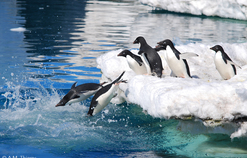

Pygoscelis adeliae (Hombron & Jacquinot, 1841)
provided by EG-BAMM, Anne-Mathilde Thierry
Description
Adélie penguin is one of the most common penguin species along the Antarctic coast, and it is probably also the most studied species. They are obligate inhabitants of the pack ice that surrounds the Antarctic continent. They breed from late October to early March in colonies that are found on ice-free coastal areas. During this time, they alternate between foraging trips at sea and sojourns on land to incubate the egg or rear their two chicks. After breeding and moulting, they spend the winter in the pack ice.
Jacques Hombron and Honoré Jacquinot published the first scientific description of Adélie penguins in 1841. These two surgeons and naturalists were part of an expedition led by French explorer Jules Sébastien César Dumont d’Urville, which was the first to reach the Antarctic continent. The section of the Antarctic coast discovered in January 1840 was named Terre Adélie after the explorer’s wife, Adèle. The first specimens of Adélie penguins were collected at this site, and named after it.
11666 times added


Species distribution
Adélie penguins are found along the entire Antarctic coast and some of its nearby islands, including the Balleny and South Shetland island groups, the South Orkney and the South Sandwich islands.
Adélie penguins are torpedo-like swimmers. They hunt their prey at depths of up to 175 m, but most of their diving activity occurs in the first 50 m of the water column.
Adélie penguins face predation by leopard seals and occasionally killer whales at sea, as well as giant petrels and skuas on land. Today the threats of global environmental change, and competition from commercial fishing, threaten the future of Adélie penguins, which rely on sea-ice and krill to breed.
Adélie penguins nest on ice-free coastal areas, but spend most of their time, including winter, in the pack ice surrounding the Antarctic continent. Adélie penguins are not found north of the pack ice during winter. Changes in sea-ice extent and the timing of its retreat can have major consequences on the breeding success of Adélie penguins.
Adélie penguins mainly feed on a mixed diet of Antarctic krill Euphausia superba and crystal krill E. crystallorophias, with smaller quantities of fish (mostly Pleuragramma antarcticum), amphipods and cephalopods. It captures such prey by pursuit diving, usually less than 20 m down.
The breeding cycle of the Adélie penguin comprises four distinct stages from mid-October to mid-February: courtship, incubation, guard stage, and crèche stage.
Male Adélie penguins are first on the colonies around October to establish territories and are soon followed by females. Females usually depart to sea to refeed after the courtship period and as soon as they complete their clutch by laying the second egg on a nest made out of small stones. Males then start to incubate the egg(s) until females return from sea, on average after 12 to 15 days. Under normal incubation routine, mates alternate between foraging trips at sea and incubation bouts on land.
The incubation period for an Adélie penguin egg ranges between 30 and 39 days. Females usually lay two eggs (mean clutch size: 1.8; egg weight: 100-125 g), and 1.6 chicks per nest hatch. Chicks hatch at the end of December and are always attended by a parent during the guard stage (ca. 22 days; range: 16-34). The crèche stage corresponds to the period during which chicks are left unattended in the colony until about mid-February, before fledging (ca. 51 days after hatching, range: 41-56). During this period, they form groups know as crèches and are regularly fed by the parents, which forage at sea simultaneously. Fledging occurs after 52 to 61 days. About one chick is fledged per breeding pair, with a mean weight at fledging of about 3 kg.
They go through one complete moult after the breeding season (February-March). Failed breeders begin to moult earlier than successful breeders. Most penguins moult on the pack ice. For those that moult on land (not necessarily on colony sites), post-breeding migration occurs after the moult.
Adélie penguins spend the winter in the pack ice. A period of feeding and fattening is followed by the spring migration to the colony. The age at first breeding is 5 to 6 years on average. Lifespan is up to 20 years.
There are no items on your guide yet!
Preview or






